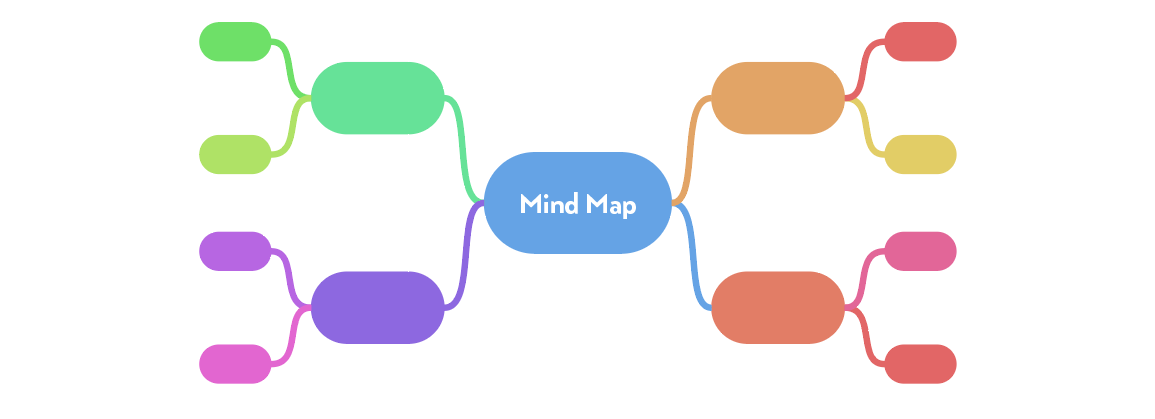Mind Mapping for Stress Relief
Stress can affect us all in different ways. For some people, it results in insomnia or causes you to eat more or less than usual. For others, it can cause unpleasant physical symptoms like a stomachache or headache. Most of us can agree that when we feel stressed, we may not have the same mental clarity as when we’re feeling more relaxed, and while we also have different ways of coping with stress, from journaling to a grounding yoga or meditation class, there may be one method you haven’t tried yet: mind mapping.
What Is Mind Mapping?
Mind mapping is a creative tool in the form of a visual diagram that helps you organize and streamline your thoughts around a central idea, allowing you to connect concepts along the way. While it’s often used for work and educational purposes, applying this technique to personal projects and problems can help you break out of your usual way of thinking and solve stress-causing issues that arise here and there.
Benefits of Mind Mapping
Here are a few science-backed benefits of mind mapping.
It’s a more effective way of remembering things. In a research study on the efficacy of mind maps as a study technique, they were shown to boost retention by 10-15%. Since mind maps aren’t linear and use a variety of words, pictures, colors, they help you create notes that are more easily recalled than traditional note-taking would.
It’s more engaging than traditional learning styles. Sitting in a classroom lecture or reading a textbook are the typical ways we learn; however, the idea-generation and more dynamic, interactive nature involved with mind mapping make it a more engaging learning tool.
It boosts creativity. In a study on young children, researchers found that mind mapping helps develop creative thinking. The creative benefits of mind mapping aren’t limited to children either. In a separate study, this time on college freshmen, the students reported that mind mapping resulted in them becoming “faster and more efficient in generating and organizing ideas.”
It enhances problem-solving skills. Mind mapping improved the critical-thinking ability in a study on nursing students, which is no surprise due to the visualization and connection of concepts it generates.
How to Make a Mind Map
Create your own mind map in a few easy steps:
Grab either a blank piece of paper turned horizontally, or opt for mind-mapping software.
Start with a central thought, idea, or problem to solve — this will be your starting point.
Add branches to this main concept with keywords or short phrases to begin organizing your thoughts. Don’t worry about if you’re doing it right — you can use it as a loose brainstorming tool, or create your own set structure.
Explore your starting point by continuing to add subtopics in their own unique branches connected to their related topics.
Different Ways to Use Mind Maps
Learning
Mind maps are a great tool for taking notes and prepping for exams. Whether you’re studying a foreign language, memorizing complex terminology for a subject, or even enriching a hobby — like watching a yoga workshop — mind maps allow you to graphically incorporate words, images, colors, and numbers making your notes memorable.
Work projects
Mind maps also make an ideal collaboration tool for team projects, allowing members to quickly generate ideas, engage in the topic, and maintain structure while still thinking creatively. You can opt to either make individual mind maps and combine them into one larger one, or mind map in a group session. They can also be used to keep or develop a meeting agenda or to record notes during meetings.
Event planning
If you’ve got a personal or project-related event coming up, like a vacation or staycation, you can use a mind map to track activities, dates, times, budget, locations, and more.
Decision making
If you’ve got a big decision weighing on you, whether it be personal or work-related, you can use a mind map to clarify your thoughts while isolating your emotions. Start by centering the problem in the middle of your mind map, then branch out into pros and cons. From there, you’ll branch out further into arguments for and against each point, eventually settling on the best course of action.
Goal setting
Goal setting without a solid plan is a surefire way to not achieve what you had hoped for. For example, if your goal is to learn how to handstand or start a daily meditation practice, branch out with what you need to learn to make that happen, how much time to dedicate to practice, how often each week you should practice, etc. By mapping out the exact steps you need to take, you’re more likely to stay on track.
Problem-solving
For all of life’s problems that crop up from time to time, like managing debt, deciding whether to change careers or relocate, or even something as simple as deciding how to spend the weekend, you can use a mind map to calm down, focus your mind, and organize all of your solutions in one highly visual place.
How Mind Mapping Can Help
Relieve Stress
While a mind map can be used for many different purposes, it’s great at allowing you to consolidate your thoughts, create connections between things you may have missed otherwise, and declutter your brain, all of which can help to alleviate stress. If you have a problem weighing on you, creating a mind map can help you freely explore your thoughts and emotions without the overwhelm that can come with keeping things inside the walls of your mind.
Pair your mind mapping session with our Yoga for Anxiety playlist, free for 14 days with a trial to Alo Moves.












